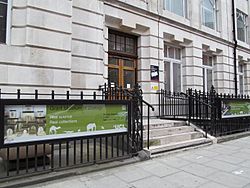Grant Museum of Zoology and Comparative Anatomy facts for kids

The exterior of the Grant Museum
|
|
| Lua error in Module:Location_map at line 420: attempt to index field 'wikibase' (a nil value). | |
| Established | 1828 |
|---|---|
| Location | University Street London, WC1 United Kingdom |
| Type | Natural history |
| Public transit access | |
The Grant Museum of Zoology and Comparative Anatomy is a fascinating natural history museum. It is part of University College London (UCL) in London, England. The museum began in 1828. It was started by Robert Edmond Grant to help students learn about animals. It is one of the oldest natural history collections in the United Kingdom. It is also the only university natural history museum left in London. The museum has many special items. These include a rare quagga skeleton and dodo bones. It also has beautiful Blaschka glass models.
Contents
History of the Museum
How It Began
Robert Edmond Grant was a very important person. He was the first professor of Zoology in England. He also founded the Grant Museum collection. He was its first curator, which is like a manager of a museum. Grant decided that the professor of Zoology at UCL would also be the museum's curator. When he passed away, he left his own collection to the museum. Other important scientists later helped grow the collection. One of them was Edwin Ray Lankester. He added many new specimens between 1875 and 1891.
A Home for Animals
The Grant Museum has been used by students at UCL since 1828. It first opened its doors to the public in 1996. In 2011, the museum moved to a new location. It is now in the Rockefeller Building. This building used to be the UCL Medical School library.
What You Can See
Amazing Specimens
The Grant Museum holds about 100,000 animal specimens. Many of these are very rare. Some have even been "rediscovered" after being lost for a long time. The museum has items from other university collections. These include specimens from Imperial College London and Queen Mary University of London. It also has items from London Zoo. You can also see specimens from famous scientists. These include Thomas Henry Huxley and Karl Pearson. The museum even has items from famous trips. These include the Discovery Expedition and the Challenger Expedition.
Gallery
-
A huge Megaloceros giganteus skeleton. It was found hanging in an Irish hotel!
-
Dodo bones that were hidden for 100 years. They were found in 2011 during the museum's move.
-
A Quagga skeleton. People didn't know it was a quagga until 1981!
-
A Rhamphorhynchus fossil. It was thought to be a fake, but it was real!






